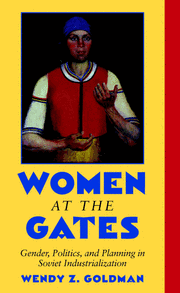Book contents
- Frontmatter
- Contents
- Acknowledgments
- List of Illustrations
- List of Tables
- Acronyms and Abbreviations
- Women at the Gates
- Introduction
- 1 Guarding the Gates to the Working Class: Women in Industry, 1917–1929
- 2 The Struggle over Working-Class Feminism
- 3 The Gates Come Tumbling Down
- 4 From Exclusion to Recruitment
- 5 “The Five-Year Plan for Women”: Planning Above, Counterplanning Below
- 6 Planning and Chaos: The Struggle for Control
- 7 Gender Relations in Industry: Voices from the Point of Production
- 8 Rebuilding the Gates to the Working Class
- Conclusion
- Index
- Plate Section
5 - “The Five-Year Plan for Women”: Planning Above, Counterplanning Below
Published online by Cambridge University Press: 30 July 2009
- Frontmatter
- Contents
- Acknowledgments
- List of Illustrations
- List of Tables
- Acronyms and Abbreviations
- Women at the Gates
- Introduction
- 1 Guarding the Gates to the Working Class: Women in Industry, 1917–1929
- 2 The Struggle over Working-Class Feminism
- 3 The Gates Come Tumbling Down
- 4 From Exclusion to Recruitment
- 5 “The Five-Year Plan for Women”: Planning Above, Counterplanning Below
- 6 Planning and Chaos: The Struggle for Control
- 7 Gender Relations in Industry: Voices from the Point of Production
- 8 Rebuilding the Gates to the Working Class
- Conclusion
- Index
- Plate Section
Summary
The fulfillment of the plan in 1931 and the following years demands a series of maneuvers from the labor force: a group of men must leave work, and women must replace them. Men, after retraining in their positions, will be sent to jobs that would be harmful to the female organism.
S. Gimmel'farb, labor economist, 1931In the summer of 1930, as hundreds of thousands of unemployed workers, peasants, and women poured through the tumbled gates to the working class, planners quietly tucked away a set of elaborate blueprints for the deployment of women in the files of the Commissariat of Labor (NKT), the State Planning Commission (Gosplan), and the Council of People's Commissars (SNK). The plans, redrafted many times, had resulted in a final, detailed document entitled “The Five-Year Plan for Female Labor.” Never published or publicly discussed, this plan had emerged from countless meetings of NKT, Gosplan, the Committee to Improve the Labor and Life of Women (KUTB), and other commissariats and departments throughout the spring and summer of 1930. Planners based their plan for female labor on intensive research into Soviet industry in 1930. Surveying the advances of rationalization and mechanization in various industries, they set target figures and training quotas for women throughout the economy, specifying their numbers and placement in various sectors, industries, shops, and jobs.
The plans, preserved in the State Archive of the Russian Federation (GARF), are fully revealed and analyzed for the first time in this chapter.
- Type
- Chapter
- Information
- Women at the GatesGender and Industry in Stalin's Russia, pp. 143 - 178Publisher: Cambridge University PressPrint publication year: 2002



